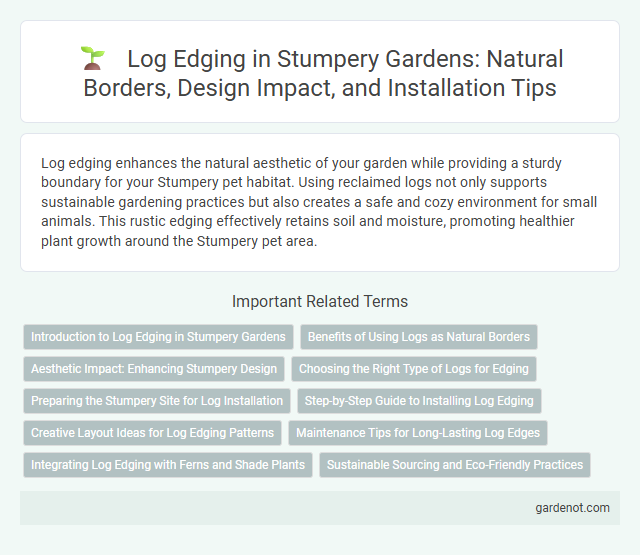Log edging enhances the natural aesthetic of your garden while providing a sturdy boundary for your Stumpery pet habitat. Using reclaimed logs not only supports sustainable gardening practices but also creates a safe and cozy environment for small animals. This rustic edging effectively retains soil and moisture, promoting healthier plant growth around the Stumpery pet area.
Introduction to Log Edging in Stumpery Gardens
Log edging in stumpery gardens creates a natural boundary by using logs to define pathways and planting areas. This technique enhances the woodland aesthetic while providing structural support to soil and plants. Utilizing locally sourced timber for log edging promotes sustainability and complements the organic, rustic charm of stumpery designs.
Benefits of Using Logs as Natural Borders
Logs as natural borders in stumperies create a rustic, eco-friendly edging that enhances garden aesthetics while promoting biodiversity. These log edges retain soil moisture, reduce erosion, and provide habitats for beneficial insects and fungi, supporting a healthy garden ecosystem. Their durability and natural decomposition enrich soil quality, making them a sustainable choice for long-term garden management.
Aesthetic Impact: Enhancing Stumpery Design
Log edging adds a rustic and natural aesthetic that complements the textured complexity of a stumpery, emphasizing the organic elements and creating a cohesive visual flow. The varied sizes and shapes of the logs introduce depth and contrast, enhancing the tactile appeal of the planting arrangement. Incorporating log edging around a stumpery accentuates its woodland charm while defining boundaries that highlight the intricate display of ferns, moss, and fungi.
Choosing the Right Type of Logs for Edging
Selecting the ideal logs for stumpery edging involves considering durability, size, and aesthetic appeal to complement the natural woodland theme. Hardwood logs like oak or cedar resist decay and provide long-lasting structure, while softer woods may require more frequent replacement. Opting for logs with irregular shapes enhances the organic look, blending seamlessly into the rustic garden landscape.
Preparing the Stumpery Site for Log Installation
Preparing the stumpery site for log edging involves clearing the area of debris and leveling the ground to ensure stable placement of logs. Logs should be selected based on size and durability, then cut and arranged to create natural-looking borders that define walkways or planting areas. Proper drainage must be considered to prevent waterlogging and prolong the life of the wooden edging in the stumpery.
Step-by-Step Guide to Installing Log Edging
To install log edging for a stumpery, first measure and mark the desired border area before sourcing durable, untreated logs approximately 3 to 6 feet in length. Next, dig a shallow trench about 4 to 6 inches deep along the marked line to secure the logs firmly in place and prevent shifting over time. Finally, position the logs vertically or horizontally within the trench, backfilling with soil or gravel to stabilize the edging and enhance the natural woodland aesthetic of the stumpery garden feature.
Creative Layout Ideas for Log Edging Patterns
Log edging offers a natural and rustic boundary ideal for garden beds, pathways, and flower borders. Creative layout ideas include arranging logs in herringbone or circular patterns for visual interest, or alternating log heights to add texture and depth. Incorporating moss or small plants between logs enhances the organic feel and integrates the edging seamlessly into the landscape design.
Maintenance Tips for Long-Lasting Log Edges
Regularly inspect log edging for signs of rot or insect damage to maintain its durability. Apply a weather-resistant sealant annually to protect the wood from moisture and UV exposure. Keep the edges clear of debris and ensure proper drainage to prevent water accumulation and prolong the lifespan of the log edging.
Integrating Log Edging with Ferns and Shade Plants
Log edging creates a natural boundary that complements the lush textures of ferns and shade-loving plants, enhancing the woodland garden aesthetic. Using reclaimed logs for edging supports moisture retention and provides a habitat for beneficial insects, promoting a healthy ecosystem. This integration emphasizes organic design elements while defining garden beds with a rustic charm ideal for shaded areas.
Sustainable Sourcing and Eco-Friendly Practices
Log edging in stumpery designs emphasizes sustainable sourcing by utilizing reclaimed or naturally fallen wood, minimizing environmental impact and preserving forest ecosystems. Eco-friendly practices include avoiding chemical treatments and selecting durable hardwoods that resist decay naturally, ensuring longevity without toxic runoff. Incorporating locally sourced materials further reduces carbon footprint and supports responsible forestry management.
Log edging Infographic

 gardenot.com
gardenot.com